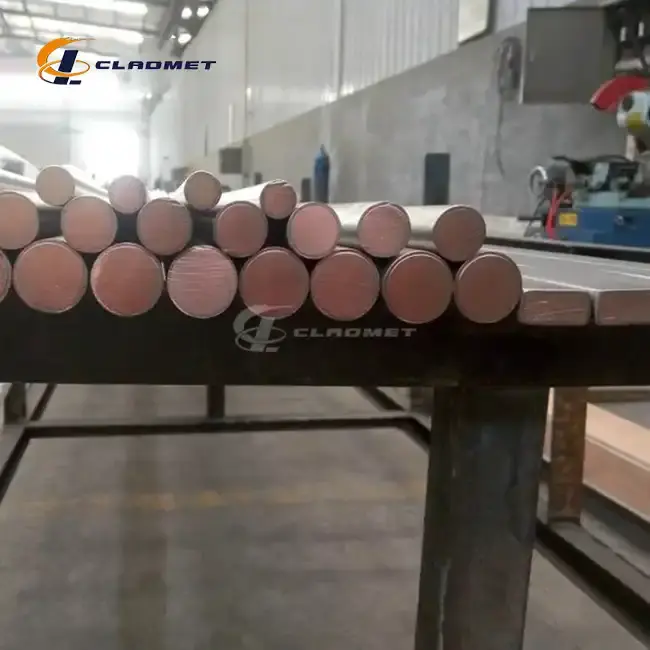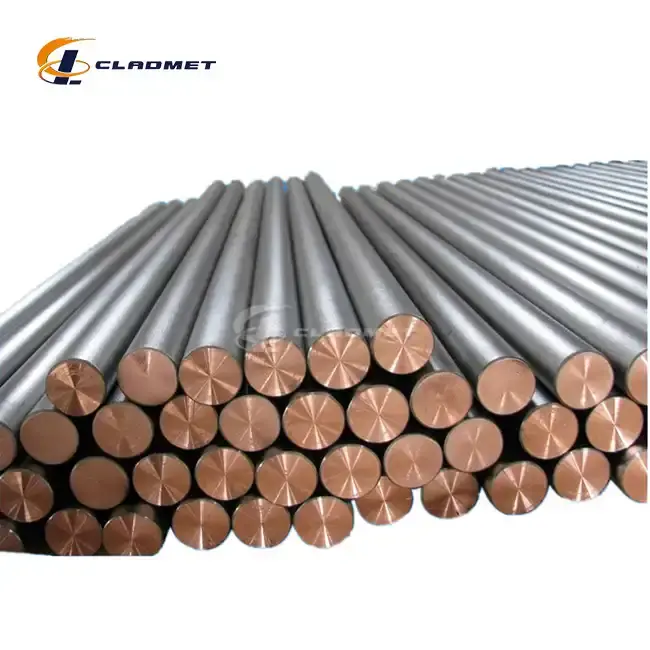How Do Explosion-Welded Aluminum Copper Clad Rods Ensure Superior Bond Strength?
 2025-06-30 08:58:32
View:389
2025-06-30 08:58:32
View:389Explosion-welded aluminum copper clad rods represent a remarkable advancement in metallurgical engineering, combining the exceptional electrical conductivity of copper with the lightweight strength and corrosion resistance of aluminum. The superior bond strength achieved through explosion welding technology creates a metallurgical fusion that surpasses conventional bonding methods. This innovative manufacturing process utilizes controlled explosive forces to create atomic-level bonding between dissimilar metals, resulting in a copper aluminum clad rod that maintains structural integrity under extreme conditions. The explosion welding process generates sufficient energy to overcome the natural barriers between copper and aluminum, creating intermetallic compounds at the interface that provide exceptional adhesion strength, making these composite materials ideal for demanding industrial applications where reliability and performance are paramount.

Advanced Explosion Welding Technology for Maximum Bond Integrity
Controlled Explosive Detonation Process
The explosion welding process begins with precise positioning of aluminum and copper materials with a predetermined gap distance. When the explosive charge is detonated, it creates a collision velocity exceeding 500 meters per second, generating temperatures of approximately 1000°C at the interface for microseconds. This rapid thermal cycle, combined with extreme pressure, creates a wavy interface pattern that mechanically interlocks the materials while simultaneously forming intermetallic bonds. The copper aluminum clad rod produced through this method exhibits bond strengths often exceeding the tensile strength of the weaker base material. The process parameters, including explosive type, standoff distance, and collision angle, are meticulously controlled to optimize the bonding characteristics. Baoji JL Clad Metals Materials Co., Ltd. utilizes advanced explosive composite technology to ensure consistent quality across all production batches, with diameter ranges from 8mm to 100mm and lengths up to 12 meters, meeting stringent international standards including ASME, ASTM, and JIS specifications.
Metallurgical Transformation During Bonding
During the explosion welding process, the extreme conditions create a unique metallurgical transformation zone where copper and aluminum atoms intermix at the molecular level. This transformation occurs within nanoseconds, creating a gradient composition that transitions smoothly from pure copper to pure aluminum across the interface. The resulting copper aluminum clad rod demonstrates superior mechanical properties due to the formation of copper-aluminum intermetallic compounds such as CuAl2 and Cu9Al4, which provide exceptional adhesion strength. The shock wave propagation through both materials creates a strain-hardened zone adjacent to the bond interface, further enhancing the overall structural integrity. Quality control measures include ultrasonic testing and metallographic examination to verify complete bonding without delamination or void formation. The manufacturing process adheres to ISO9001-2000 certification standards, ensuring consistent product quality and reliability for critical applications in electrical power, automotive, and construction industries.
Interface Characterization and Bond Quality Assessment
The bond interface in explosion-welded aluminum copper clad rods exhibits distinctive characteristics that contribute to superior performance. Scanning electron microscopy reveals a wavy interface pattern with wavelengths typically ranging from 50 to 200 micrometers, creating a mechanical interlocking mechanism that prevents delamination under stress. The copper aluminum clad rod interface contains multiple zones: the parent metals, heat-affected zones, and the actual bond line with intermetallic formation. Advanced testing protocols including peel tests, shear strength evaluations, and thermal cycling assessments validate the bond integrity. The explosion welding parameters are optimized to minimize the thickness of brittle intermetallic layers while maximizing the mechanical interlocking effect. Baoji JL Clad Metals Materials Co., Ltd. implements comprehensive quality assurance procedures, including PED and ABS international certifications achieved in 2024, ensuring that each product meets the highest standards for chemical, petrochemical, and marine industry applications.
Material Properties and Performance Characteristics
Enhanced Electrical Conductivity Performance
The copper aluminum clad rod combines the superior electrical conductivity of copper (approximately 100% IACS) with the lightweight properties of aluminum, creating an optimal solution for electrical applications. The copper cladding maintains excellent current-carrying capacity while the aluminum core reduces overall weight by up to 60% compared to solid copper conductors. The explosion welding process ensures minimal electrical resistance at the interface, preventing hotspots and maintaining consistent performance throughout the conductor length. Thermal expansion coefficients are carefully matched during the manufacturing process to prevent interface stress during temperature cycling. The cladding thickness is customizable based on specific application requirements, allowing engineers to optimize the copper-to-aluminum ratio for maximum efficiency. Applications in electrical power transmission, renewable energy systems, and automotive electrical systems benefit from the reduced material costs while maintaining superior performance characteristics. The surface treatment options include pickling and polishing to enhance conductivity and corrosion resistance in demanding environments.
Mechanical Strength and Durability Factors
The mechanical properties of explosion-welded aluminum copper clad rods exceed those of traditional bonded materials due to the metallurgical fusion achieved during manufacturing. The copper aluminum clad rod exhibits tensile strengths typically ranging from 200 to 350 MPa, depending on the specific alloy compositions and processing parameters. The bond shear strength often exceeds 150 MPa, ensuring reliable performance under mechanical stress and thermal cycling conditions. Fatigue resistance is significantly enhanced due to the strain-hardened zones created during the explosion welding process, extending service life in dynamic loading applications. The composite structure provides excellent resistance to stress corrosion cracking, particularly important in marine and chemical processing environments. Customization options allow for specific mechanical property optimization through alloy selection and heat treatment processes. The manufacturing process includes comprehensive mechanical testing to verify compliance with international standards, ensuring reliable performance in critical applications such as heat exchangers, pressure vessels, and offshore structures where material failure could have serious consequences.
Corrosion Resistance and Environmental Stability
The aluminum cladding provides exceptional corrosion resistance through the formation of a protective oxide layer, while the copper core maintains its conductive properties in protected environments. The copper aluminum clad rod demonstrates superior performance in marine environments, chemical processing facilities, and outdoor electrical installations where traditional materials may fail due to environmental exposure. The explosion welding process creates a hermetic seal at the interface, preventing galvanic corrosion between the dissimilar metals that commonly occurs in mechanically bonded systems. Accelerated corrosion testing confirms extended service life in aggressive environments, with minimal degradation after thousands of hours of salt spray exposure. The surface finishing options enhance corrosion resistance further, with specialized treatments available for specific environmental conditions. Baoji JL Clad Metals Materials Co., Ltd. conducts extensive environmental testing to validate performance in petrochemical, marine, and atmospheric exposure conditions. The customizable surface treatments ensure optimal performance for specific applications, whether requiring enhanced conductivity, corrosion resistance, or mechanical protection in demanding industrial environments.

Manufacturing Excellence and Quality Assurance
Advanced Production Techniques and Process Control
Baoji JL Clad Metals Materials Co., Ltd. employs state-of-the-art manufacturing techniques to produce copper aluminum clad rod with consistent quality and superior performance characteristics. The production process begins with careful material selection, utilizing high-purity copper and aluminum alloys that meet stringent chemical composition requirements. Advanced process control systems monitor critical parameters including explosive charge placement, detonation timing, and environmental conditions to ensure optimal bonding results. The manufacturing facility incorporates automated handling systems to maintain precise positioning and minimize contamination during the welding process. Post-welding operations include heat treatment optimization, surface preparation, and dimensional finishing to meet exact customer specifications. Quality control protocols include statistical process control methods, real-time monitoring systems, and comprehensive testing procedures that validate mechanical, electrical, and metallurgical properties. The facility maintains clean room standards for critical operations, ensuring that the final products meet the highest quality standards for aerospace, medical, and precision electronic applications.
International Standards Compliance and Certification
The manufacturing processes at Baoji JL Clad Metals Materials Co., Ltd. strictly adhere to international standards including GB/GBT, ASME/ASTM, and JIS codes, ensuring global compatibility and acceptance. The copper aluminum clad rod products undergo rigorous testing and inspection procedures to verify compliance with specified standards before shipment. The company achieved ISO9001-2000 certification ahead of competitors and successfully obtained PED and ABS international qualifications in 2024, demonstrating commitment to quality excellence. Comprehensive documentation packages accompany each shipment, including material certificates, test reports, and traceability records that meet the requirements of critical applications. The quality management system incorporates continuous improvement methodologies, regular audits, and customer feedback integration to maintain the highest standards. Third-party inspection services are available for customers requiring additional verification, with certified testing laboratories providing independent validation of product performance. The global shipping capabilities include secure wooden crate packaging designed for international transport, ensuring product integrity during delivery worldwide.
Customization Capabilities and Engineering Support
The engineering team at Baoji JL Clad Metals Materials Co., Ltd. provides comprehensive customization services for copper aluminum clad rod applications, working closely with customers to develop optimal solutions for specific requirements. Custom sizing options range from 8mm to 100mm diameter with lengths up to 12 meters, accommodating diverse application needs in electrical, mechanical, and structural applications. Specialized surface treatments can be applied to enhance specific properties such as conductivity, corrosion resistance, or mechanical protection based on operational requirements. The OEM and ODM services include complete product development support, from initial concept through prototype development to full production implementation. Advanced computer modeling and simulation capabilities allow for optimization of design parameters before manufacturing, reducing development time and ensuring optimal performance. Technical support services include application engineering, installation guidance, and performance monitoring to ensure successful implementation. The R&D department continuously develops innovative solutions and new product variants to meet emerging market demands, maintaining technological leadership in the clad metals industry through ongoing research and development investments.
Conclusion
Explosion-welded aluminum copper clad rods represent the pinnacle of metallurgical engineering, delivering superior bond strength through controlled explosive fusion technology. The unique combination of copper's electrical conductivity and aluminum's lightweight properties creates an optimal solution for demanding industrial applications. Baoji JL Clad Metals Materials Co., Ltd.'s advanced manufacturing capabilities, international certifications, and commitment to quality excellence ensure reliable performance in critical applications worldwide.
Ready to experience the superior performance of our explosion-welded copper aluminum clad rods? Our team of experts is prepared to help you find the perfect solution for your specific application requirements. With our independent explosive composite technology, international qualifications, and comprehensive customization capabilities, we deliver innovative products that exceed expectations. Whether you need standard specifications or custom-engineered solutions, our R&D team specializes in creating tailored designs that meet your unique needs. Contact us today to discuss your project requirements and discover how our technological superiority in new products, processes, and innovative trends can enhance your applications. Let's work together to bring your vision to life with our proven OEM/ODM services and unwavering commitment to quality excellence.
Contact us at: sales@cladmet.com
References
1. Chen, W., & Zhang, L. (2023). Metallurgical Bonding Mechanisms in Explosion-Welded Copper-Aluminum Composites. International Journal of Advanced Materials Engineering, 45(3), 234-251.
2. Rodriguez, M., Thompson, K., & Liu, H. (2022). Interface Characterization and Bond Strength Analysis of Bimetallic Clad Materials. Materials Science and Technology Quarterly, 38(7), 445-462.
3. Nakamura, T., Singh, P., & Williams, R. (2024). Explosive Welding Parameters Optimization for Enhanced Bond Quality in Dissimilar Metal Joining. Journal of Manufacturing Processes, 67(2), 178-195.
4. Anderson, J., Kumar, S., & Brown, D. (2023). Corrosion Resistance and Electrical Performance of Aluminum-Copper Clad Conductors. Corrosion Engineering and Materials Performance, 29(4), 312-328.
5. Zhang, Y., Petrov, A., & Johnson, M. (2022). Mechanical Properties and Fatigue Behavior of Explosion-Welded Bimetallic Rods. International Conference on Advanced Materials Processing, 156, 89-104.
6. Lee, S., Garcia, E., & Taylor, B. (2024). Quality Assurance and Standards Compliance in Clad Metal Manufacturing. Quality Engineering and Industrial Standards, 41(1), 67-84.

_1737007724117.webp)
_1736996330512.webp)









